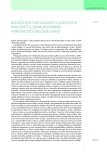The essentials of physics of extracorporeal shock wave lithotripsy
Authors:
Kamil Fógel
Authors‘ workplace:
Urologická klinika 1. LF UK a VFN v Praze
Published in:
Ces Urol 2010; 14(2): 73-80
Category:
Review article
Overview
Extracorporeal Shock Wave Lithotripsy (ESWL) utilizes a specific acoustic characteristics of a shock wave, which enables fragmentation of urinary stone. Shock wave is a acoustic wave generated by the shock wave source with high energy and variable frequency. Stone disintegration is caused by interaction of the shock between two acoustically different mediums. The main mechanisms of shock wave action is spallation, squeezing, acustic cavitation and compression. This method was invented and introduced to the clinical practice in the early 1980s in Germany and from that time this method has earned it’s position as a firstline treatment option in nearly 90% of patients with urinary stones.
Key words:
extracorporeal shock wave lithotripsy, mechanism of shock wave action, physics, shock wave.
Sources
1. Chaussy C, Brendel W, Schmiedt E. Extracorporeally induced destruction of kidney stones by shock waves. Lancet 1980; 2 : 1265–1268.
2. Benes J, Sunka P, Kralova J, Kaspar J, Pouckova P. Biological effects of two successive shock waves focused on liver tissues and melanoma cells. Physiol Res 2007; 56(Suppl 1): S1–S4.
3. Cleveland RO, McAteer JA. The Physics of Shock Wave Lithotripsy. In: Smith AD, Badlani G, Bagley D, Clayman R, others a eds, Smith’s Textbook Of Endourology. Hamilton-London: BC Decker Inc 2006; 317–332.
4. Kuwahara M, Kambe K, Kurosu S, et al. Clinical application of extracorporeal shock wave lithotripsy using microexplosions. J Urol 1987; 137 : 837–840.
5. IEC61846, Ultrasonics – Pressure pulse lithotriptors – Characteristics of fields, T. Ultrasonics, Editor 1998.
6. Danuser H, Muller R, Descoeudres B, Dobry E, Studer UE. Extracorporeal shock wave lithotripsy of lower calyx calculi: how much is treatment outcome influenced by the anatomy of the collecting system? Eur Urol 2007; 52 : 539–546.
7. Evan AP, Lynn WR. Extracorporeal Shock Wave Lithotripsy: Complications. In: Smith AD ed, Smith’s Textbook of Endourology. Hamilton – London: BC Decker Inc.; 2006 : 353–362.
8. Tan EC, Tung KH, Foo KT. Comparative studies of extracorporeal shock wave lithotripsy by Dornier HM3, EDAP LT 01 and Sonolith 2000 devices. J Urol 1991;
146 : 294–297.
9. Kerbl K, Rehman J, Landman J, et al. Current management of urolithiasis: progress or regress? J Endourol 2002; 16 : 281–288.
10. Sass W, Braunlich M, Dreyer HP, et al. The mechanisms of stone disintegration by shock waves. Ultrasound Med Biol 1991; 17 : 239–243.
11. Eisenmenger W. The mechanisms of stone fragmentation in ESWL. Ultrasound Med Biol 2001; 27 : 683–693.
12. Coleman AJ, Saunders JE, Crum LA, Dyson M. Acoustic cavitation generated by an extracorporeal shockwave lithotripter. Ultrasound Med Biol 1987; 13 : 69–76.
13. Willis LR, Evan AP, Connors BA, et al. Relationship between kidney size, renal injury, and renal impairment induced by shock wave lithotripsy. J Am Soc Nephrol 1999; 10 : 1753–1762.
14. Eisenmenger W, Du XX, Tang C, et al. The first clinical results of „wide-focus and low-pressure“ ESWL. Ultrasound Med Biol 2002; 28 : 769–774.
Labels
Paediatric urologist Nephrology UrologyArticle was published in
Czech Urology

2010 Issue 2
Most read in this issue
- Less common causes of dysuria in women
- Percutaneous radiofrequency ablation (RFA) in the management of renal tumours – own experience
- Advanced methods of external-beam radiation therapy in the treatment of prostate cancer
- Complications of treatment with bacillus calmette-guerin (BCG) in nonmuscle - invasive bladder cancer
